
|   |

|   |
Samakala festival of contemporary dance - Kedar Mishra e-mail: kedarsikha@gmail.com Photos courtesy: Odisha Tourism June 14, 2013 (The review appeared originally in Odisha360.com) Can the silence speak? Silence can be stunningly evocative, but at the same time it can also be a fertile ground for pandemonium. Purest silence leaves no space for chaos or cacophony. When an artist picks up silence as his or her medium of expression, there he/she needs to be extra careful. In the contemporary format of Indian dance, artistes shuttle between musical zones of sound and soundlessness to express their ideas of abstraction. However, one must not think that soundlessness is silence itself. Silence is the purest form of music and creative beauty which can never be achieved by mechanical arrangements. With an unusual soundlessness, the second edition of Samakala, a festival of contemporary dance presented by Odisha Tourism and organized by Odisha Sangeet Natak Akademi began on June 11, 2013 at Rabindra Mandap, Bhubaneswar, giving detrimental scope to whispers, mobile caller tunes and stupid words of disturbances. Dry geometry of body Brilliant dancer and choreographer Padmini Chettur signed into the show with extremely slow moves. Her solo presentation in contemporary style was based on different positions of the body using time as powerful strategy. The composition was an abstract idea lacking coherence and communicability. It was pure technicality and geometric representation of a toned body. In the choreography, showing different aspects of the body movements relating to time and space was definitely a brilliant concept. However, a confusing way of expression makes it drier. Half of the composition goes in utter soundlessness (not silence), that kills its musicality. Even deconstruction happens in a rhythm. Again dance is not all about body; sometime dance liberates body from its limitations and spots out that great spark of eternity in the body itself. I was keenly waiting and watching to feel the moment of spark, but that spark never came, proving her act to be too mechanical. 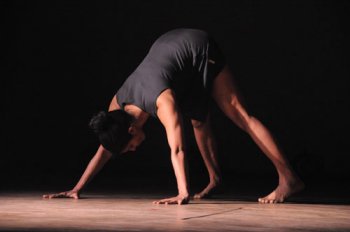 Padmini Chettur 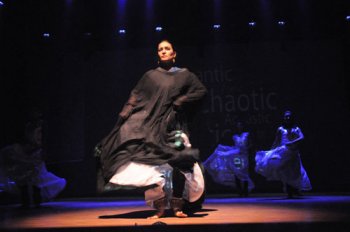 Ashavari Majumdar Funny and philosophical I donít know whether fun and philosophy can go together or not, but in Ashavari Majumdarís act on Surpanakha, they walked hand in hand. Ashavari experimenting with Kathak brings all kinds of good and beautiful things into her composition. She knows every good thing about dancing like techniques, style, appropriate use of props, music, lighting, multimedia utility on stage, space management etc. What she does not know is where to stop and how to put things in order. Talking on diverse Ramayana and bringing Surpanakha as a strong protagonist is something quite fascinating. Use of fun (which remains untouched as our dancers are too serious) and juxtaposing theater elements makes it interesting. It starts with a brilliant aalap based on raag Jog, moves with graceful dignity, becomes funny in the middle and ends up as a gimmick. The group work deserves a pat and bringing such diverse opinions on a particular character from Ramayana is indeed appreciable. With that Ashavari must note that the art of garlanding is more imperative than the art of collecting the flowers. Body and outside the body Martha Graham, the pioneer of Contemporary dance once said, ďThe body is your instrument in dance, but your art is outside that creature, the body.Ē Being in the body and displaying an art beyond it is the biggest challenge a dancer faces all the time. And if you have a body, not so toned, not so exciting to show, then what could you do? Stop dancing? If you are an ordinary mortal, yes, you can. But if you are Astad Deboo, you cannot be bracketed within a body. You are beyond and absolutely free of your body bondage. It was Astad Deboo, the grand master of Indian contemporary dance who dominated the whole show on the second evening of Samakala. Song of the soil It was Gurudev Rabindranath Tagore who was the prime mover of creative spirit this evening. Both the artistes of the evening Anita Ratnam and Astad Deboo took Gurudevís poems as their baseline. Inaugurating the evening, Anita presented three brilliant solo pieces portraying womanhood with color, vigor and versatility. Choosing Sita from Ramayana, Anita came up as a modern woman displaying her willpower to fight the fire and firmly ascertained the womanís identity. Beautiful footwork mixing Bharatanatyam and Contemporary, balanced facial expression and exactitude of emotion through body movement made the work quite moving. Later, it was Tagoreís Meenakshi Basanti, a song based on Carnatic style of singing that was the highlight. Anitaís balanced body and poetic movements conveyed the spirit of nature and motherhood with grace and dignity. Her final piece Avani was an ode to mother earth. A good combination of narration and abstraction, soothing music, terrific management of light and shadow on stage and a deep conceptual choreography. 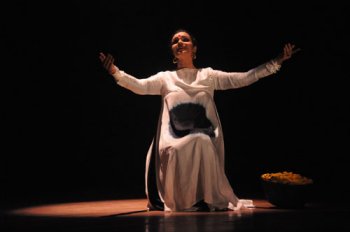 Anita Ratnam 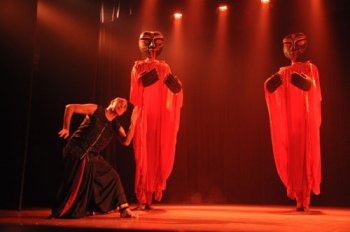 Astad Deboo The inventor, the grandmaster There is a lot of emphasis on body in contemporary dance and here we saw a man with not a very exciting body. An old, not so eye arresting figure. But he is magic personified. He is moving music himself. One can see a panorama of postures, gestures, expression and philosophical constructs. It was Astad Deboo coming on to the stage with complete surrender. When it was said that the first piece of Astadís work is named Surrender, there was no need for words. His body came out from its own frame and surrendered itself to the unknown. The move in his body synchronized a great range of dance vocabularies from Kathak to Kathakali, from Thang Ta, Kalaripayattu to western contemporary. It was pure delight of liberation. What Martha Graham said about the charm of art beyond the body. His rendezvous with life sized puppets depicting ĎYour Graceí was a piece of marvel in color, costume, movements and action. Tagoreís Ekala Chalo added few dramatic moments. Finally, the Awakening, Astadís masterpiece of complete liberation. Showing chakkar of Kathak and taking it to a mystic level of whirlwind. It was a soulís journey into eternity. A great evening with greater art works. In the morning, US based renowned contemporary dancer, scholar and art critic Uttara Asha Coorlawala gave a brilliant talk on modern dance showing her own artistic journey as a performer and choreographer. Back to the line of Nijinsky Hundred years back, Vaclav Nijinsky, the maverick prince and rebel of modern dance composed an out of box piece called ĎAfternoon of a Fauní and that piece is revisited after a century by a Malaysian dancer, trained in Indian styles of Odissi and Bharatanatyam. That was Ramli Ibrahimís tribute to Nijinsky on the concluding evening of Samakala festival. The three-day festival concluded with Ramli Ibrahimís Sutra presenting Transfiguration, a series of fusion containing eastern and western forms of dancing. There was Odissi, Bharatanatyam and Ballet. Radiating strength Earlier Navtej Johar and Sunil Kumar duo arrived on stage facing each other and transforming their body into a couple of mighty bows. Navtej, a brilliant Bharatanatyam dancer discovered contemporary beauty in ancient Bharatanatyam vocabulary. Navtejís composition Dravya Kaya intended to explain visceral exchange between objects and their human users explored through three objects from Ramayana- Ramaís bow, Sitaís bark robe and the famous Lakshman Rekha on the earth. It was an unusual presentation in Bharatanatyam frame and looked deliberately crude. But there was flexibility in the idea that made it interesting. But the concluding piece presenting a monologue of Sita in Ashoka Vatika killed the established intensity of the composition. It was a badly written monologue. Sita reading Kabir, Nanak, Namdeb, watching television and learning English was gimmicky. I donít know what inspired an artiste of Navtejís caliber to go in for something like this 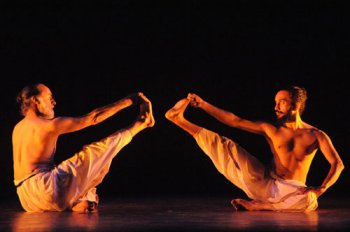 Navtej Johar and Sunil Kumar 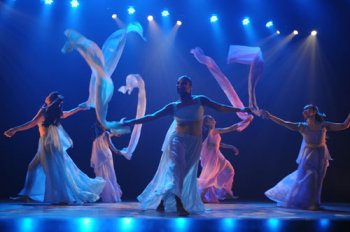 Ramli Ibrahimís group Fusing Eastern and Western The concluding program of the evening was by Ramli Ibrahimís acclaimed Sutra from Malaysia. The group without Ramli looked a bit poor. It was quite a young group and comparatively looked like in their formative phase. The well established perfection of Sutra was missing. Transfiguration, a three episodes production began with Kamala, displaying the power of creation, creativity and motherhood through the portrayal of Indian and western goddesses and their symbols. Second was Nijinskyís famous Afternoon of a Faun, which can easily be branded as the show stealer. It was perfect and poetic. River Sutra was a long fusion of Ganesh Vandana, Pibare Rama rasam, Sthayi based on raag Basant, the famous Krishna ni begane baro and Thillana. I donít know whether it was five episodes or one episode containing five elements. There was no linking line, nor did they move continuously. From a diehard professional like Ramli it was not expected. As usual, Sutraís magician Shivarajah Natarajan showed his charisma in light designing. Shiva is an extraordinary talent who knows how lights and shadows supplement and compliment on stage. The well organized and well projected festival was a very successful one as we got an opportunity to see variety and variations. |